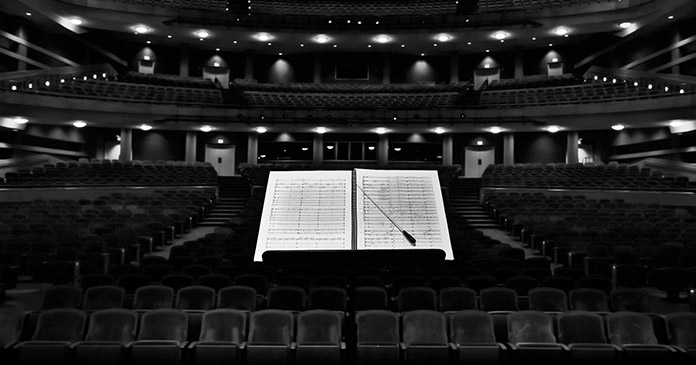
I am sitting on the stage in the first row of a large symphony chorus. The orchestra is in front of me, warming up. Everyone is playing individual passages and scales all at once. Beyond that, there’s a vast audience.
There’s a low rumble as people speak softly, find their seats and unwrap their last-minute cough drops. The players stop playing. The rumble in the audience lessens to a near silence as the house lights go out. The concert master enters the stage to applause and tunes the orchestra. The director and soloists now come on stage to louder applause, take their bows. The soloists take their seats. The maestro takes the podium.
A single butterfly flutters happily in my gut as the conductor motions for the chorus to rise. I do a subtle last-minute neck stretch and take a couple of slow deep breaths. We have already been here for two hours warming up. We have rehearsed over fifty hours for this performance and I have driven at least a hundred hours getting to and from the rehearsals.
We are ready. I am ready.
Bright lights briefly blind me. Everything beyond the director fades to black. Nothing beyond him matters anyway. I have a direct view of him across the orchestra. With the chorus beside and behind me, I am both exposed and protected. Knowing every note by heart, the music in our hands is but a reminder of what is to come. We are focused on every movement of the maestro, every facial expression, every breath. The orchestra, the chorus, the soloists and the director–we are one.
Soon the orchestra begins. The chorus joins in. Gradually the orchestra disappears, then the chorus and soloists follow. The director disappears, and finally, I disappear. There is no technique to worry about, no tuning to be concerned with. No audience. No judgement. Only music. We are one. We are music.
I am standing in the pew at Mass reviewing my mental shopping list, wondering what’s for lunch. The priest is rambling words I’ve heard a million times. Suddenly, behind me I hear feathers ruffling–ffft, ffft. I turn to see my guardian angel, wings flitting like a nervous parrot.
He’s moving his head, stretching his neck, rotating his shoulders and pumping his knees like a runner about to take his mark. “What are you doing?” I whisper. “It’s almost time,” he answers.
“The Sanctus is coming. It’s our song. It’s what we do. See the priest? Soon he will become ‘alter Christus,’–another Christ. That bread will become the precious body of the Lord, and that wine will become his precious blood. All the angels and saints are gathered and ready to sing. Do you see them? Do you feel them? How can you just stand there, thinking about lunch?”
I look up. The roof fades away, The assembly of angels and saints now hover above and everywhere. My dearly departed parents, grandparents and friends are among them already singing. They fidget in joyful anticipation for the moment that we in the pews will join them to sing their unending hymn of praise. They are one. They are one with us. Jesus is one with us all.
I am now fixed on every movement and every word of the priest. Somehow, he looks different. More heavenly? I do a subtle last-minute neck stretch and take a slow deep breath as the priest bids us to sing. The people disappear. Then the pews. Then the building. There are no angels or saints. We are all one. Now there is simply praise as the King of Glory prepares to descend to be among us.
We know what words we will sing for the Sanctus, but what kind of music will we sing? What style? What level of beauty? What music befits this moment?
Will we shrug, singing something that sounds like music we might hear in the grocery store while shopping for lunch? Or will we sing something that shows that we recognize Christ in all his glory as he comes to be with us, body, soul, blood and divinity?
Music can help those in the pew recall their shopping list, or it can help them recognize where they are, who they are, and what they are doing. Choosing music is a huge responsibility. Are you ready? Listen… “Ffft, ffft.”
